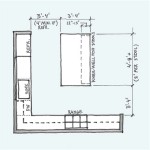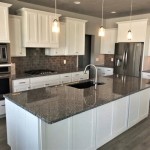How to Prepare for a Kitchen Remodel
A kitchen remodel is a significant undertaking, requiring careful planning and preparation to ensure a smooth and satisfactory outcome. The kitchen is often considered the heart of the home, and disruptions to its functionality can impact daily life. A well-executed remodel can increase property value, improve functionality, and enhance the overall aesthetic appeal of the home. However, poor preparation can lead to cost overruns, delays, and frustration. This article outlines key steps to take before embarking on a kitchen remodel, ensuring a more organized and efficient process.
Defining Your Needs and Wants
The first step in preparing for a kitchen remodel is a thorough assessment of your current kitchen and a clear articulation of your desired improvements. This involves identifying aspects of the existing kitchen that are functional and those that are not. Consider your current cooking habits, storage needs, and the overall flow of the space. Are you an avid cook who needs ample counter space and a professional-grade range? Or do you primarily use the kitchen for light meal preparation and entertaining?
Create a detailed list of “needs” and “wants.” Needs are essential elements that must be addressed in the remodel, such as improved storage, better lighting, or addressing structural issues. Wants are desirable features that are not strictly necessary but would enhance the kitchen's functionality or aesthetics, such as a wine refrigerator, a specific type of countertop material, or updated appliances. Distinguishing between needs and wants helps to prioritize budget allocation and make informed decisions throughout the remodeling process.
Gather inspiration from various sources, such as magazines, websites, and home improvement shows. Create a mood board or a digital scrapbook to visualize your desired aesthetic and identify specific design elements that appeal to you. Consider factors such as color schemes, materials, and overall style. This visual representation will be invaluable when communicating your vision to designers and contractors.
Consider the kitchen's relationship to other rooms in the house. Do you want to open up the kitchen to a living room or dining area? This may involve structural changes and should be considered early in the planning process. Also, think about the traffic flow through the kitchen and how the remodel will affect the movement of people within the space.
Developing a Realistic Budget and Timeline
Establishing a realistic budget is a crucial step in preparing for a kitchen remodel. Kitchen remodels can range in cost from a few thousand dollars for minor cosmetic updates to tens of thousands of dollars for a full-scale renovation. It is essential to research the average cost of kitchen remodels in your area and to factor in all potential expenses.
Begin by researching the cost of materials, such as cabinets, countertops, appliances, flooring, and fixtures. Obtain quotes from multiple suppliers to compare prices and ensure you are getting the best value for your money. Remember that the cost of materials can vary significantly depending on the quality and brand. Consider the long-term value of your investment when selecting materials, as higher-quality materials may require less maintenance and last longer.
Labor costs are another significant expense to consider. Obtain quotes from multiple contractors and ensure that the quotes include a detailed breakdown of labor costs for each phase of the remodel. Be sure to ask about their experience, licensing, and insurance coverage. A reputable contractor should be able to provide references and examples of their previous work. It is also essential to have a written contract that outlines the scope of work, payment schedule, and timeline.
Contingency funds are critical for unforeseen expenses that may arise during the remodel. It is generally recommended to set aside 10-20% of the total budget for unexpected costs, such as plumbing or electrical issues, structural repairs, or changes to the design. Having a contingency fund provides peace of mind and prevents financial strain if unexpected expenses arise.
Developing a realistic timeline is equally important. Kitchen remodels can take anywhere from a few weeks to several months, depending on the scope of the project. Work with your contractor to establish a detailed timeline that outlines each phase of the remodel, from demolition to installation. Be prepared for potential delays due to material availability, unforeseen issues, or contractor scheduling. Regular communication with your contractor is essential to stay informed about the progress of the project and to address any potential issues promptly.
Researching and Selecting Professionals
The success of a kitchen remodel often hinges on the selection of qualified professionals. Whether you opt for a general contractor, a kitchen designer, or individual tradespeople, thorough research and vetting are essential.
Start by obtaining recommendations from friends, family, or neighbors who have recently completed kitchen remodels. Online review sites can also provide valuable insights into the reputation and quality of work of local contractors and designers. Check for any complaints or negative reviews and consider how the company responded to those concerns.
Interview multiple contractors and designers before making a decision. Ask about their experience with similar projects, their design philosophy, and their approach to project management. Request to see examples of their previous work, either in person or through a portfolio. A reputable professional should be able to provide references from satisfied clients.
Verify that the contractor is licensed and insured. Licensing ensures that the contractor meets certain standards of competence and professionalism. Insurance protects you from liability in case of accidents or damage during the remodel. Ask to see proof of insurance and licensing before signing a contract.
Obtain detailed written bids from each contractor, outlining the scope of work, materials, labor costs, and payment schedule. Review the bids carefully and compare them to ensure that they include all aspects of the project. Be wary of bids that are significantly lower than others, as this may indicate substandard materials or workmanship.
Once you have selected a contractor, review the contract thoroughly before signing. The contract should clearly outline the scope of work, payment schedule, timeline, and any warranties or guarantees. Ensure that the contract includes provisions for change orders and dispute resolution. Do not hesitate to ask questions or seek legal advice if you are unsure about any aspect of the contract.
Preparing the Kitchen and Living Space
Before the demolition phase begins, it is essential to prepare the kitchen and surrounding living space to minimize disruption and protect your belongings. This involves taking steps to protect furniture, relocate items, and establish a temporary kitchen.
Protect furniture and flooring in adjacent rooms by covering them with plastic sheeting or drop cloths. Remove any valuable or fragile items from the kitchen area to prevent damage during demolition and construction. Consider storing these items in a secure location, such as a spare room or a storage unit.
Pack up all kitchen items, including dishes, cookware, utensils, and appliances. Label each box clearly to make it easier to find items when you need them. Consider donating or selling items that you no longer need or use. This is a good opportunity to declutter and simplify your kitchen inventory.
Establish a temporary kitchen in another area of the house. This may involve setting up a microwave, a toaster oven, and a portable sink in a spare room or a dining area. Keep essential kitchen items readily accessible for meal preparation. Consider purchasing disposable plates, cups, and utensils to minimize cleanup.
Protect yourself from dust and debris by sealing off the kitchen area with plastic sheeting. Use painter's tape to secure the plastic to the walls and doorways. Consider purchasing an air purifier to remove dust particles from the air. Wear protective gear, such as a dust mask and safety glasses, when entering the kitchen area.
Communicate with your family members about the construction schedule and any potential disruptions. Establish rules for entering the kitchen area and ensure that everyone is aware of the safety precautions. Regular communication and cooperation can help to minimize stress and maintain a positive atmosphere during the remodel.

8 Tips To Prepare For A Kitchen Remodel Stress Free Guide

Prepping For A Kitchen Remodel What To Do First At Home With Ashley

11 Tips For Hiring A Kitchen Renovation Contractor

10 Ways To Prepare For A Kitchen Remodel Renovation Tips

13 Steps To Prepare For A Kitchen Remodel

Getting Ready For A Kitchen Remodel The Best Ways To Pack Prepare

How To Prepare For A Kitchen Remodel Project Renovation Tips From The Pros

Kitchen Remodel Checklist How To Prepare For Your Royal Palm Closet

How To Prepare For A Kitchen Remodel Cabinet Iq

Preparing For A Kitchen Remodel Anita Yokota








